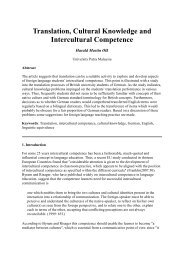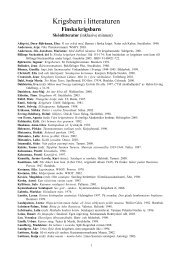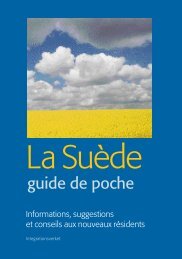Going Home: Deculturation Experiences in Cultural Reentry
Going Home: Deculturation Experiences in Cultural Reentry
Going Home: Deculturation Experiences in Cultural Reentry
You also want an ePaper? Increase the reach of your titles
YUMPU automatically turns print PDFs into web optimized ePapers that Google loves.
contact with another culture <strong>in</strong> the contexts of language, customs, dress, and worldview.<br />
Second, the condition of the orig<strong>in</strong>al culture has changed. Physical, l<strong>in</strong>guistic, social,<br />
religious, familial, and technological changes may have occurred dur<strong>in</strong>g the visitor’s absence.<br />
Additionally, views and responses from others toward the re-entrant may have changed as<br />
well, perhaps based on assumption that the sojourner’s experiences have changed him or her.<br />
Jansson (1975) expla<strong>in</strong>s this very succ<strong>in</strong>ctly:<br />
In most cases, there is a shift <strong>in</strong> values, a portion of "history" that is not<br />
mutually shared, and behaviors which differ from those expected with<strong>in</strong> the<br />
social system. The re-entrant is <strong>in</strong> the m<strong>in</strong>ority and is, <strong>in</strong> a sense, def<strong>in</strong>ed by<br />
those who rema<strong>in</strong>ed <strong>in</strong> the group. (136)<br />
The purpose of this article is to <strong>in</strong>vestigate the deculturation process used <strong>in</strong> theoretical<br />
approaches to adaptation. This is done by us<strong>in</strong>g the context of the sojourner’s return home to<br />
determ<strong>in</strong>e the extent to which deculturation is evident. F<strong>in</strong>d<strong>in</strong>gs are then compared to<br />
<strong>in</strong>tercultural approaches to the adaptation process.<br />
The adaptation process occurs when <strong>in</strong>dividuals travel from one culture to another, both <strong>in</strong><br />
long and short term encounters. Along with this movement, there seems to be a process of<br />
adjustment and familiarization with the new situation. This adjustment has been labeled as<br />
socialization and has several processes (Gudykunst & Kim 2003, 1997). They are<br />
enculturation, which is the learn<strong>in</strong>g of the culture; acculturation, which <strong>in</strong>volves the process<br />
of resocialization; deculturation, which is the unlearn<strong>in</strong>g of the orig<strong>in</strong>al culture; and f<strong>in</strong>ally<br />
assimilation, which is a state of high deculturation of the orig<strong>in</strong>al culture and acculturation of<br />
the new culture. Accord<strong>in</strong>g to Gudykunst and Kim, these sociological processes form the<br />
foundation of communication <strong>in</strong>vestigations, and communication is vital to this process<br />
because adaptation occurs <strong>in</strong> and through communication.<br />
Adaptation theory has as its tenets the concepts of acculturation and deculturation.<br />
Acculturation occurs when <strong>in</strong>dividuals, "become acqua<strong>in</strong>ted with and adopt some of the<br />
norms and values of salient reference groups of the host society. As acculturation takes place,<br />
however, some unlearn<strong>in</strong>g of old cultural patterns occurs as well…" (Gudykunst & Kim<br />
1997: 337). Through the adaptation process an <strong>in</strong>dividual develops new responses that are<br />
adopted <strong>in</strong> situations that previously would have evoked different ones. Accord<strong>in</strong>g to this<br />
theory, then, when one adapts to a new cultural structure, there is an unlearn<strong>in</strong>g of orig<strong>in</strong>al<br />
cultural habits.<br />
The above discussion provides the follow<strong>in</strong>g research question:<br />
RQ1: Is the theoretical description of deculturation supported by reentry experiences?<br />
Sample<br />
Method<br />
In order to conduct the comparison of theories, as well as understand/verify what happens<br />
when <strong>in</strong>dividuals return from a secondary culture to the one of their orig<strong>in</strong>, the sample must<br />
consist of <strong>in</strong>dividuals with the follow<strong>in</strong>g characteristics. First, they must have traveled to and<br />
returned from a different cultural context. Second, some sort of <strong>in</strong>terest <strong>in</strong> function<strong>in</strong>g <strong>in</strong> that<br />
culture should have been evident <strong>in</strong> their stay. Third, they should have rema<strong>in</strong>ed <strong>in</strong> that

















